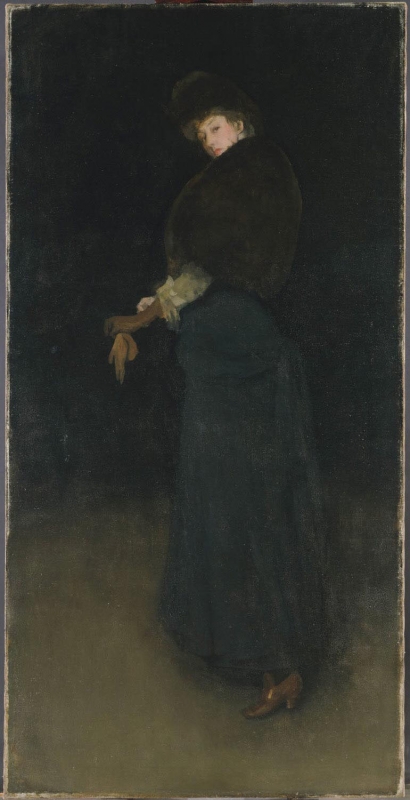Arrangement in Black: La Dame au brodequin jaune – Portrait of Lady Archibald Campbell was probably started in 1882 and, although first exhibited in 1884, may have been completed in the following year. 1

Arrangement in Black: La Dame au brodequin jaune – Portrait of Lady Archibald Campbell, Philadelphia Museum of Art
On 29 March 1882 Whistler refused to show 'Lady Archie's portrait ... until it is entirely completed.' 2
The Pennells implied that this portrait was painted after Portrait of Lady Archibald Campbell in Court Dress [YMSM 240] and The Grey Lady: Portrait of Lady Archibald Campbell [YMSM 241] in about 1882, and quotes a letter from the sitter in which she stated, 'I think I sat to him [Whistler] during a year or so, off and on, for a great many studies in different costumes and poses'; she added that, when she returned to London after sittings for The Grey Lady: Portrait of Lady Archibald Campbell [YMSM 241] had been interrupted, Whistler asked to make a study of her 'in the dress in which I called upon him', and that this became Arrangement in Black: La Dame au brodequin jaune - Portrait of Lady Archibald Campbell [YMSM 242]. 3
Théodore Duret (1838-1927) was posing at the same time (see Arrangement en couleur chair et noir: Portrait de Théodore Duret [YMSM 252]). The Pennells write:
'We have heard of a dramatic scene just outside the studio: Lady Archibald Campbell in a hansom, on the point of driving away never to return; M. Duret springing on the step, representing to her the loss to the world of the masterpiece if she refused to stand for it again, and arguing so well that she did come back.' 4
According to Blackburn, a 'Portrait of Lady Archibald Campbell' in 'dark grey dress and fur cape' was exhibited in the VIII Summer Exhibition, Grosvenor Gallery, London, 1884 (cat. no. 192). 5 Around this time, according to William Booth Pearsall (1845-1913), he saw Lady Archibald Campbell posing, in Whistler's Fulham Road studio, 'a large room with a high light in the roof. A lady was sitting for her portrait, or rather standing in a corner on a sheet.' 6 According to Harbron, Beatrice Philip (Mrs E. W. Godwin, Mrs J. McN. Whistler) (1857-1896) was in the studio while the portrait was being painted. 7
The portrait was first exhibited in the Paris Salon in 1885 (cat. no. 2459) as 'Portrait de Lady Archibald Campbell'.
Notes:
1: YMSM 1980 [more] (cat. no. 242).
2: Whistler to Mrs Maxse, GUW #13640.
3: Pennell 1908 [more] , vol. 1, pp. 305-07.
4: Ibid., vol. 1, p. 307.
5: Blackburn, Henry, Grosvenor Notes, London, 1884, p. 41.
6: Pennell 1908, op. cit., vol. 2, p. 28.
7: Harbron, D., The Conscious Stone: The Life of Edward William Godwin, London, 1949, p. 167.
Last updated: 8th June 2021 by Margaret





